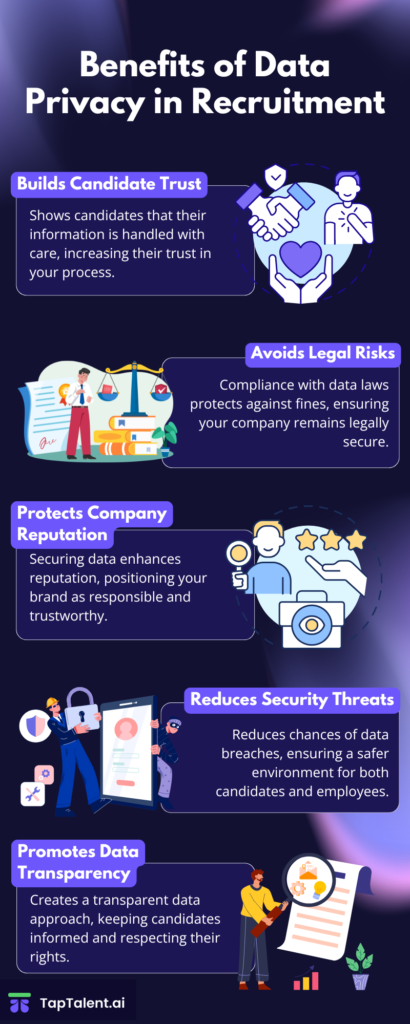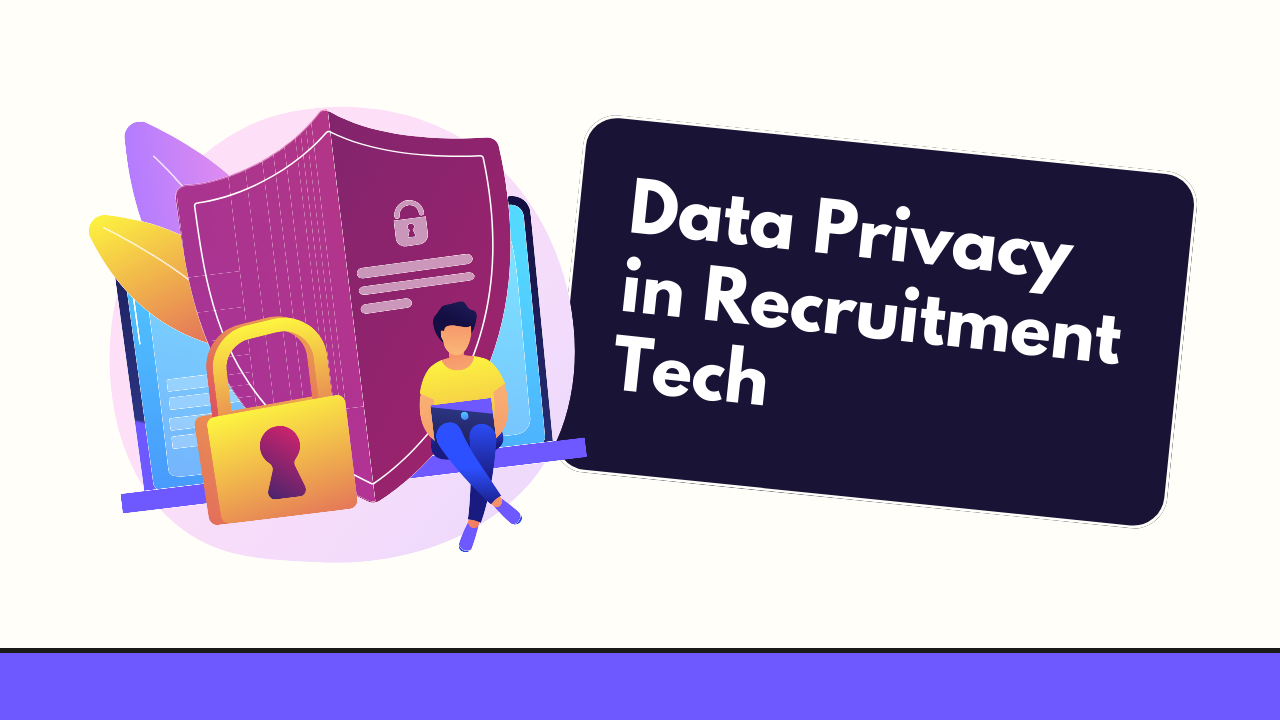In an era where data breaches make headlines and consumer trust is more fragile than ever, the recruitment industry finds itself at a crossroads. Did you know that data breaches in recruitment can lead to severe legal and reputational damage, eroding trust that takes years to build? This is where “data privacy in recruitment” takes center stage, emerging as not just a compliance necessity but a cornerstone of ethical recruitment practices. For businesses aiming to safeguard candidate information while maintaining transparency, understanding data privacy is crucial.
In this blog post, we will unravel the complexities of data privacy in recruitment, starting from the legal frameworks like GDPR and CCPA that govern how candidates’ personal data is handled. Expect to uncover best practices for data handling and storage, strategies to build candidate trust, and the technological solutions that can optimize data privacy. Whether you’re a recruiter or a tech enthusiast, learning to prioritize data privacy can be a game-changer. Dive in as we explore how to transform data privacy from a challenge into a strategic advantage, setting your organization up for long-term success.

Best Practices for Data Handling and Storage
To manage data privacy in recruitment effectively, employing best practices for data handling and storage is crucial. These practices not only comply with legal requirements but also foster trust with candidates. Let’s explore the key strategies:
1. Data Minimization
Start by implementing data minimization principles, which involves collecting only essential data needed for recruitment and recruitment analytics. For example, instead of gathering full addresses, a postal code might suffice for geographical data analysis. Minimizing the data collected reduces exposure in the event of a data breach.
2. Secure Data Storage
Ensure that sensitive candidate information is stored securely. This means utilizing secure servers, strong encryption protocols, and robust access control measures. According to a report by Cybersecurity Ventures, damages related to cybercrime are expected to hit $10.5 trillion annually by 2025, emphasizing the importance of strong security measures.
3. Data Encryption
Adopt various data encryption methods to protect information both in transit and at rest. For instance, Advanced Encryption Standard (AES) is a widely used protocol known for its high level of security. Encryption helps ensure that even if unauthorized access occurs, the data remains inaccessible.
4. Access Control
Implement role-based access control, which restricts sensitive data access to authorized personnel only. This minimizes risks of data breaches from within the organization. Research by IBM indicates that insider threats cause around 60% of data breaches, highlighting the need for stringent access controls.
5. Data Retention Policies
Develop clear data retention policies to determine how long data should be stored and when it should be securely deleted. Regularly review these policies to align with changing regulations like GDPR. Secure deletion practices, such as using specialized software to erase data, ensure compliance.
6. Third-Party Vendor Management
Thoroughly vet third-party vendors to ensure they possess adequate security measures to protect candidate data. For example, confirm that your Applicant Tracking Systems (ATS) providers comply with relevant data protection laws and standards.
7. Regular Security Audits
Conduct regular security audits to identify vulnerabilities in your systems and processes. These audits can help detect potential risks before they lead to breaches, maintaining the integrity and confidentiality of candidate data.
By incorporating these best practices, recruiters can avert severe data breaches, uphold trust, and adhere to legal frameworks governing data privacy. Transitioning to a culture of comprehensive data security, recruitment teams can reassure candidates that their personal information is safe, thereby enhancing candidate trust.
As we transition to the next section, we’ll explore how organizations can foster this trust further by ensuring transparency and clear communication with candidates.
Building Candidate Trust Through Transparency and Communication
In the world of recruitment, trust is the cornerstone of successful candidate relationships, especially when it comes to handling personal data. As outlined in the previous section, while technical measures are critical, fostering candidate trust through transparent practices and clear communication is equally vital. Imagine a situation where you apply for a position and provide sensitive information, but you’re left in the dark about how that data is used. It’s not a comforting thought. Transparency alleviates such concerns, ensuring candidates feel secure and respected.
Transparency in Data Usage
To begin with, transparency involves clearly communicating to candidates what data is being collected and for what purposes. This can be likened to a clear roadmap—when candidates understand the journey their data will take, they are more likely to trust the process. A case in point is the recruitment software company, Greenhouse, which notably outlines its data practices in straightforward terms on its platform. Such openness in data handling helps demystify the process and strengthens candidate confidence in the system.
Obtaining Explicit Consent
Gaining explicit consent from candidates is a fundamental practice in data privacy. This isn’t merely a checkbox formality but a legal requirement under regulations like GDPR. Recruiters should articulate what data will be collected and how it will be used. Providing detailed information in layman’s terms, much like when signing an agreement, ensures candidates are fully aware and agreeable, strengthening the trust bond. It’s a practice that goes beyond compliance—it’s about respect and ethical standards.
Data Subject Access Requests
An essential aspect of building trust includes facilitating data subject access requests. Candidates have the right to access, correct, or delete their data upon request. Consider a scenario where a candidate wishes to update their contact information; a streamlined process for such requests not only complies with regulatory requirements but also enhances the candidate’s trust in the recruitment process. Organizations, like Oasis Labs, have developed platforms where data subject requests can be efficiently managed, proving their commitment to both legal obligations and candidate empowerment.
Crafting Clear and Accessible Privacy Policies
Privacy policies should not be buried in complex legal jargon. Instead, they should reflect simplicity and clarity, making it accessible to every potential candidate. These documents act as a guiding light, explaining how data is protected and the measures in place to ensure compliance with privacy laws. Companies like LinkedIn have set benchmarks with their user-friendly privacy policies that are easy to find and understand, further ensuring candidates feel informed and secure.
Secure Communication Channels
While it’s crucial to have secure systems in place, the channels used to communicate during the recruitment process must be secure as well. Using encrypted email services or secure applicant tracking systems can prevent unauthorized access. Reputable recruitment platforms, like Workable, have integrated secure communication features into their services. These features reassure candidates that their personal information remains protected throughout their recruitment journey.
Transitioning to the upcoming section, it becomes clear that technology plays a pivotal role in enhancing data privacy practices. In the next section, we will explore how advanced technological solutions, like AI-powered tools and privacy-focused applicant tracking systems, can further bolster these privacy efforts. As we move forward, remember that transparency and communication are not just strategies—they are commitments to ensuring data privacy in recruitment becomes a shared value rather than a guarded secret.

Leveraging Technology for Enhanced Data Privacy
Advanced Tools for Compliance and Trust
As we move from transparency and communication to the role technology plays in data privacy, it becomes evident that advanced tools are crucial. They not only streamline processes but also enhance the security of candidate data. Begin with Applicant Tracking Systems (ATS), which have evolved with privacy-focused features to ensure both compliance and trust. For instance, taptalent.ai integrates privacy controls directly into its system, offering functionalities such as automatic data encryption and user access management. This way, recruiters do not have to worry about unauthorized access, as these features proactively safeguard data.
Data Anonymization for Privacy-Friendly Analytics
Moreover, technology now enables data anonymization techniques—critical for balancing privacy with analytical needs. By replacing identifying information with pseudonyms or aggregated data, organizations can analyze trends and patterns without compromising individual identities. Consider research platforms where data scientists use anonymized data to generate insights without breaching privacy protocols. This approach resembles looking at the ‘big picture’ without exposing the finer details, allowing companies to make informed decisions while respecting candidates’ privacy.
AI as a Privacy Automation Ally
Artificial Intelligence (AI) tools serve as another powerful ally in automating privacy tasks. For instance, AI can be employed to routinely scan databases and identify outdated or irrelevant candidate information—a task often seen as mundane. Automating the deletion of such data not only tightens security but also aligns with data minimization practices mentioned earlier. Think of AI as a diligent guardian that ensures your data repository is both clean and compliant.
Real-Time Monitoring with SIEM Systems
Furthermore, Security Information and Event Management (SIEM) systems bring real-time monitoring and responsive action into the fold. These systems detect anomalies or potential breaches in the recruitment process, offering immediate responses to mitigate risks. Consider SIEM akin to a vigilant watchtower, constantly scanning the horizon for threats and deploying defenses when necessary. By incorporating SIEM, companies can maintain a proactive stance on data security, enhancing candidate confidence in their privacy measures.
Training and Staying Updated on Technology
Practical tips for recruiters include frequent training on the latest tech tools and privacy practices. Incorporating simulations of data breaches can prepare teams for real-world scenarios, ensuring they remain ready to safeguard candidate data under any circumstance. Given the fast-paced evolution of technology, staying updated on industry trends and adapting accordingly ensures organizations remain at the forefront of data privacy.
The Necessity of Technological Integration
Overall, integrating technology into data privacy processes not only provides improved security but also streamlines recruitment operations, allowing recruiters to focus on forming genuine connections with candidates. As we transition into the conclusion of this discussion, remember that prioritizing advanced technological solutions in recruitment isn’t just a trend—it’s a necessity for long-term success in data privacy.
Conclusion: Prioritizing Data Privacy for Long-Term Success
As we’ve seen throughout this blog post, data privacy in recruitment is not just a buzzword; it’s a fundamental pillar of candidate trust and organizational integrity. With the surge in technology-driven recruitment processes, prioritizing data privacy ensures not only compliance with ever-evolving regulations but also reinforces the trust candidates place in your organization. Ignoring data privacy issues can lead to significant legal repercussions and can severely damage your company’s reputation.
To summarize, we’ve explored essential legal frameworks, such as GDPR and CCPA, which lay down the groundwork for compliant data practices. These regulations are not merely hurdles but guideposts for ethical data handling. By adhering to best practices in storage and minimizing unnecessary data collection, organizations mitigate risks and foster candidate confidence. Moreover, transparency and precise communication serve as bedrocks for building trust, ensuring candidates are well-informed and comfortable with how their data is handled.
In addition, technology remains a powerful ally in enhancing data privacy measures. Incorporating advanced tools like privacy-focused Applicant Tracking Systems, data anonymization techniques, and AI-assisted privacy management fortifies the recruitment process against data breaches. Real-time monitoring systems such as SIEM offer proactive protection, analogous to security guards continuously patrolling your digital premises.
Looking forward, here are some actionable tips to integrate these learnings into practice:
Develop a privacy checklist to ensure all aspects of data privacy are regularly reviewed and updated.
Invest in continuous training for recruiters about the importance of data privacy and emerging technologies.
Consider periodic third-party audits to assess the robustness of your data security measures.
Ultimately, enhancing data privacy in recruitment requires a collaborative effort. This journey towards robust data privacy measures isn’t a solitary sprint but a marathon requiring shared commitment across departments. As recruitment evolves, organizations that prioritize data privacy will not only safeguard their data but will also emerge as leaders who define industry standards.
Equipped with these insights and practices, you can reinforce your data privacy framework, instill greater trust among candidates, and pave the way for sustained success. Remember, safeguarding candidate data is akin to protecting a treasure—you must build strong defenses to foster trust and ensure organizational longevity. Engage your teams in this mission, and together, you will transform data privacy challenges into strategic opportunities for growth and resilience.




